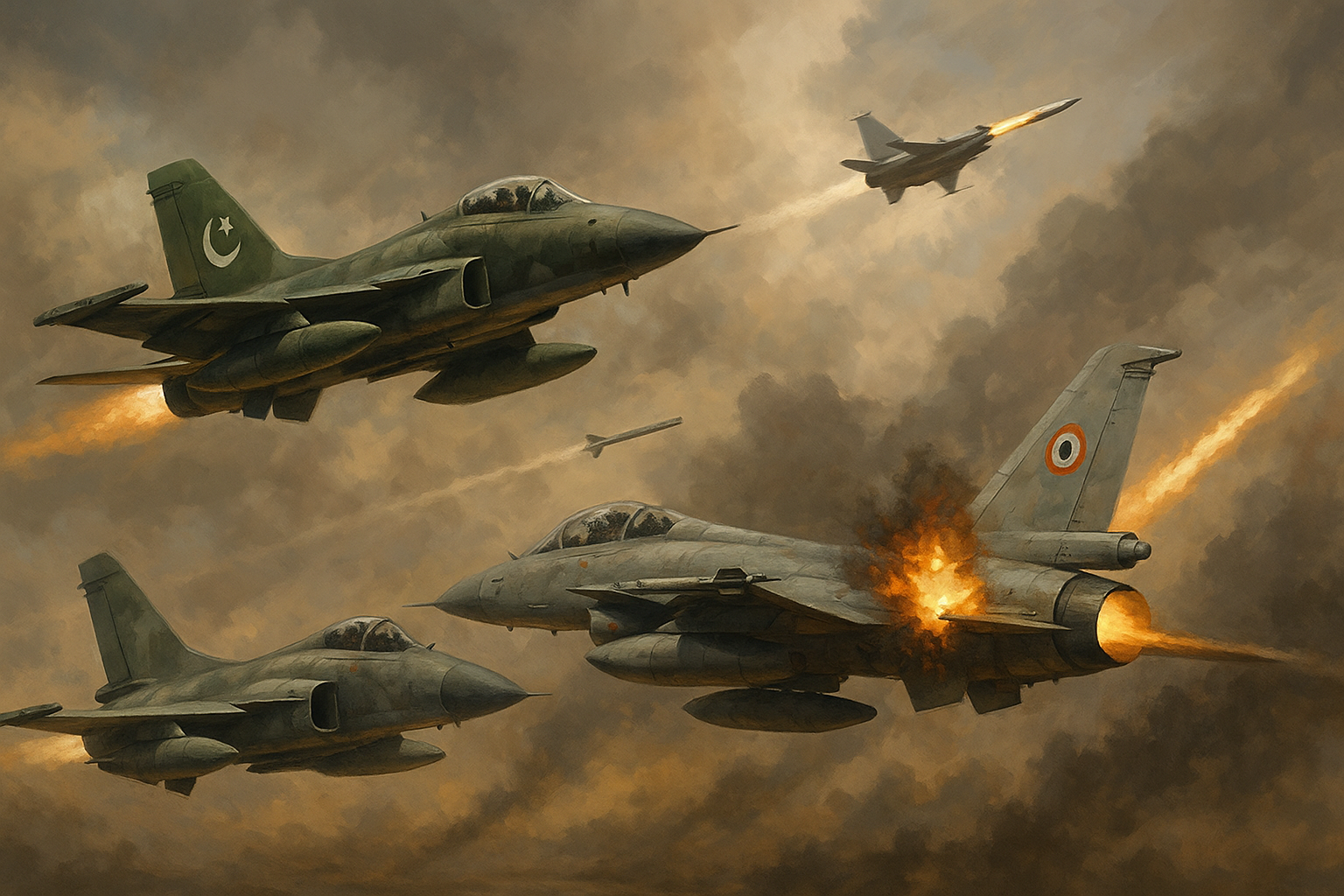Asif Iqbal
Grand strategy is the art of looking beyond the present battle and calculating ahead. Focus on your ultimate goal and plot to reach it. ~ Robert Greene, The 33 Strategies of War
On 4th of July 2025 – no pun intended regarding the date – the Indian Deputy Chief of Army Staff (Capability Development and Sustenance), Lieutenant General Rahul R(awat) Singh, came to the fore and while addressing on “New Age Military Technologies: Industry Capabilities & Way Forward” conference-cum-exhibition organised by Federation of Indian Chambers of Commerce and Industry (FCCI), elicited interesting, yet flawed, lessons cum takeaways from the ‘famous’ Operation Sindoor. The audience included senior officers, industry leaders from the defence sector, reps of technology firms, defence analysts, and members of FICCI, yet the intended target audience seemed more like the ones who foresaw India as a hot contender to China’s so-called expansionist designs. The gist of the ‘lessons’ given by the great ‘strategist’ are:
- Escalation Control: He described the ceasefire a “masterstroke,” emphasizing restraint and the challenge in managing the escalation ladder once hostilities commence.
- Target Selection: The emphasis of Operation Sindoor focused ‘exclusively’ on engaging ‘terrorist’ targets, and not military installations.
- Information Warfare: India signalled its intent through strategic communication, to limit the conflict by informing Pakistan that only militant targets were engaged.
- Calibrated Response: India’s response was calibrated and proportionate to Pakistan’s retaliation when it sought to escalate by targeting Indian military assets. India responded by striking Pakistani military targets, which led Pakistan to seek a ceasefire.
- Technological Edge: There is a need for rapid technological advancement and enhanced air defence, since Pakistan was being provided real-time battlefield support and advanced drones from China and Turkey.
- Multi-Domain Threats: India faced a three-pronged challenge, with China providing intelligence and Turkey supplying drones to Pakistan, emphasizing the importance of preparedness against multi-domain threats.
Undoubtedly, the narrative portrayed is rife with ambiguities, factual inaccuracies and selective omissions. By naming and accusing China and Turkey for aiding Pakistan, India has unequivocally ranted the old mantra of being a victim of outside meddling. Realistically, after all the contemplation and introspection, was it the best that the Indian Armed Forces could come up with!? The ‘champion’ of Quad and aiming to become a regional hegemon – the ultimate dream of Akhand Bharat – woke up from the dream to realise that dreams seldom come true and ground realities, as they are, are quite harsh. Despite this, the collective thought is over-ridden with Hindutva philosophy and the urge to promote a self-appeasing narrative and any improvement seems distant.
The credit for so-called “masterstroke” of escalation control eventually leading to ceasefire goes to the US President and his team, when Damodar Savarkar’s blind follower and butcher of Gujrat was taken aback by the retaliatory calculus of Pakistan’s Armed Forces. Similarly, how can you expect that there would be no response or any retaliation, when you target civilian centres of a sovereign country, resulting in the death of 40 individuals, including 7 women and 15 children, and over 120 individuals injured. The purported ‘terrorist centres’, thanks to the input provided by Parag Jain – the ‘super sleuth’ and now promoted as R&AW Chief – and seconded by Modi’s star NSA Ajit Doval, were nothing but civilian targets, as duly verified by international media, including Reuters, BBC and Al Jazeera.
Since the Pahalgam farce, no credible or independently verified evidence linking Pakistan directly to the attack on tourists or to the militant groups allegedly responsible, has been brought up by the Government of India and interestingly, like a good Bollywood movie, the story keeps on jumping from one side to the other without any head or toe, yet there are some notable climaxes. So, when Lieutenant General Rahul Singh says that strategic communication was used to let Pakistan know that they are going to attack the ‘terrorist centres’, did it really involve listening to the reply from the Pakistani side. Carl von Clausewitz said “War is the continuation of policy by other means”, but then the ultimate goal of war is to achieve a desired political outcome. Did India achieve it, that is one question that the Indian war mongers need to answer.
India failed to generate a ‘calibrated response’ whereas it was Pakistan that responded in a measured yet effective manner, by bringing down IAF’s entire kill chain compounded with precise missile and drone attacks – a tit for tat response by engaging only military targets. The retaliatory calculus was efficient and to the point, depicting cohesion, simultaneity, synchronousness, seamless fusion and technical edge in multidomain operations – the ultimate finesse of any field commander. IAF was brought to a complete halt when four ‘state-of-the-art’ Raffaels were shot down with resounding precision in an impeccable manner – the US President Theodore Roosevelt said, “The man behind the gun makes the difference, not the gun itself.”
Despite claims of being encircled by adversaries, India relished direct military and intelligence support from the US and Israel during Operation Sindoor. As per the reports published in The Diplomat and The Times of India,Israeli drones and weapon systems were instrumental in the strikes on Pakistan, while the US provided diplomatic cover by backing India’s right to self-defence – so much so for countering ‘multi-domain threats’. The address by ‘master strategist’ failed to acknowledge the limited strategic gains, if there were any, for India and the swift reversion to a ceasefire that was internationally brokered and pressured by major powers to deescalate. Indian strategists need to re-visit the drawing board and understand the ground realities.
India’s narrative closely resembles Israel’s approach in its conflicts with Iran and Gaza by portraying itself as a perpetual victim of hostile neighbours while using overwhelming force and then seeking international sympathy. Both countries have refrained from or distanced themselves from international criticism of each other’s military actions, reinforcing a pattern of mutual justification and selective outrage. The RSS guidebook needs a serious revision since such antics do not work anymore. Seemingly, there is a pattern to blaming the neighbours for its own shortcomings, may it be security related matters, economic and diplomatic issues and the ‘usual suspects’ are Pakistan, China, Bangladesh and Nepal. The blame-game has eroded the trust not only among the neighbours but also in the region and resultantly the trust deficit is now a major hurdle in regional integration, peace and any problem-solving may it be bilateral or otherwise.
The much-touted and proud External Affairs Minister, Dr. Subrahmanyam Jaishankar, is turning out to be a failure since India failed to garner widespread international endorsement for its operation, Sindoor. The EU and UN called for restraint and de-escalation, while China and Iran criticised India’s actions and urged a peaceful resolution. As if this jolt was not enough, neighbourly relations with Bangladesh, Nepal, Sri Lanka, Maldives and Bhutan have deteriorated largely because of its Hindutva-driven policies, perceived arrogance due to its economy and regional power play, and economic protectionism. The plan to position itself as regional power in South Asia has backfired and failed miserably, since all neighbours are now turning towards China and other powers for security and economic partnerships. Likewise, India got a taste of its own medicine when the US government levied fresh tariffs in retaliation for its own protectionist trade policies. Domestically, the Hindutva ideology has alienated apathetic minorities and has given way to overall distrust among South Asian neighbours, who view India’s policies with suspicion and as expansionist and intolerant. This has eroded regional goodwill and hindered cooperation. To add icing at the top, the Parliamentary Diplomatic Mission, India’s post-Operation Sindoor diplomatic mission involving parliamentarians, comprising multi-party MPs including Shashi Tharoor, Asaduddin Owaisi, Manish Tewari, Salman Khurshid, etc was an ambitious yet futile effort to rally international support, sway global opinion in its favour and isolate Pakistan diplomatically – it could not fulfil the desired objectives and exposed the limitations of its current foreign policy.
India’s current trajectory fuelled with Hindutva’s philosophy and propelled through Modi’s idiosyncrasies will not only have regional but international implications. Employing R&AW’s kill teams for neutralization operations in near and distant countries may give a short-term advantage per se, but is a fallacy of invincibility. The suspension of Indus Basin Water Treaty is a knee-jerk reaction when things are not going as perceived or desired and only indicates frustration. Indian strategists need to rethink their policies, be more pragmatic and recalibrate their approach towards other countries. A return to Gandhi’s secular philosophy would not be a bad start.
For now, Pakistan holds most of the cards and rest assured, it has not shown all.
The author is a security and geo-political analyst affiliated with The Strategic Brief



